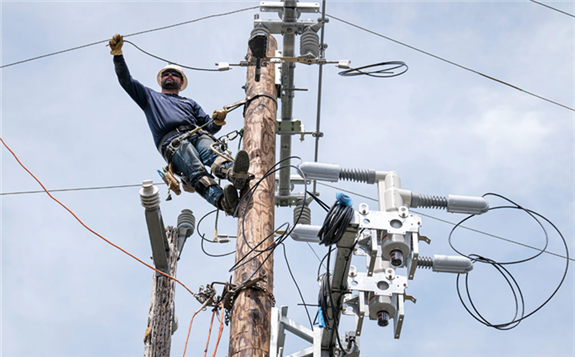The nation’s aging power grid and burgeoning clean energy sector are set to get major boosts under a $550 billion bipartisan infrastructure deal reached by the Senate and the White House.

Although details of what’s in the deal are still scarce, the agreement includes $73 billion to expand clean sources of energy and the ability to move it from place to place, in what the White House calls the “single largest investment in clean energy transmission in American history.” It includes an additional $7.5 billion to build out electric vehicle charging stations across the U.S. as the nation seeks to wean itself from gas-guzzling cars and trucks.
At the same time, the deal will clear away major impediments to adopting clean energy and work to cut red tape that has complicated efforts to build sorely needed new power lines, according to a White House description of the agreement.
It’s a far cry from the eye-popping numbers President Joe Biden initially proposed in March in his American Jobs Plan, which included $100 billion for the power grid, $174 billion for electric vehicles and $46 billion for clean energy manufacturing. But Democrats are expected to shoehorn much of the spending left out of the bipartisan deal into their separate, $3.5 trillion spending bill they plan to pass without Republican support.
A look at the clean energy provisions in the bipartisan deal:
New transmission lines
Two of the biggest energy challenges – resilience and emissions – both depend on a common factor: the energy grid.
The more reliably interconnected the electricity network is, the better any region can handle disruptions that affect local own power-generating abilities. This year’s electricity crisis in Texas illustrated how the state’s isolation from other power sources has left it with insufficient backup if things go wrong.
Transmission lines are also critical to widespread adoption of renewable energy like wind, solar and geothermal. Fossil fuel plants like coal and natural gas can generally be built close to where the electricity will be used. But clean energy often must be transported long distances to communities from parts of the country where, for example, it’s windy or sunny.
That requires new high-voltage transmission lines – and the White House says the $73 billion investment will include building “thousands of miles of new, resilient transmission lines” to help expand renewable energy.
'Grid deployment authority'
Another huge obstacle to construction new power lines is the endless red tape and finding sites where you can get permissions to build, power industry analysts say.
Unlike with interstate oil or gas pipelines, there’s no single, federal authority you can apply to for permission to build power lines. Long-distance, high-voltage lines cross multiple states, municipalities and other jurisdictions that all may require different permits – or not grant them at all.
The bipartisan deal will create a new federal entity, called a Grid Deployment Authority, to “finance and encourage the development of high-voltage transmission lines,” the White House says. Housed within the Energy Department, the authority will make use of existing public property –highways, roads and railways – to secure rights-of-way for new power lines.
Electric vehicles
The $7.5 billion for electric vehicle charger stations is the first such investment by the federal government, the Biden administration says. But it’s less than 5 percent of the amount Biden initially said was needed to meet his goal of erecting a half-million charger stations across the country.
Consumers regularly cite “range anxiety” – the fear that an electric vehicle will run out of charge before they can recharge it – as a key reason they’ve waited to go electric. The White House says the funding will be focused on deploying chargers along highways, within communities and in places that are “rural, disadvantaged and hard-to-reach.”
Other spending
The infrastructure deal also seeks to speed up development of smart grids, advanced transmission and “next-generation technologies,” although it’s not immediately clear exactly how much funding will be dedicated to those priorities or how it will be spent.
Notably, the White House singled out several technologies that would be prioritized that are generally considered “clean,” but not “renewable.” That means they produce less or no greenhouse gas emissions, but still use up a fuel that doesn’t exist in endless amounts, like the sun and wind.
Among them: Advanced nuclear reactors, as well as carbon capture, an emerging but expensive technology that seeks to capture carbon dioxide emissions from burning coal or natural gas and store it before it can enter the atmosphere. The administration also said the deal includes “clean hydrogen,” in which renewable electricity is used to create hydrogen gas that can then be burned with almost no emissions.
CORRECTION (July 29, 2021, 4:37 p.m. ET) A previous version of this article misstated the price tag of the Democrats’ spending bill. It is $3.5 trillion, not $3.5 billion.